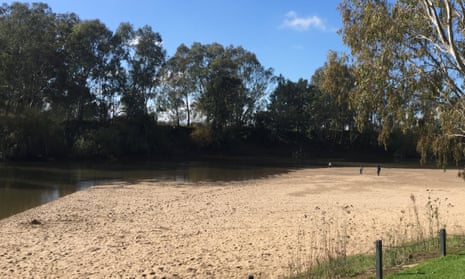Environmental groups have accused the federal government of paying a record price to retrieve water for the environment by funding irrigators to make savings through efficiencies.
The water minister, Keith Pitt, has announced the government will allocate $126m to Murrumbidgee Irrigation for works that it says will save just 7.4 gigalitres of water, and return 6.3 gigalitres to the environment.
But environmental groups say this amounts to paying a record $20,000 per megalitre for water in the Murrumbidgee Irrigation Area, almost eight times what would be paid if the government was to buy water rights on the water market.
The latest grant, made as part of the $1.3bn off-farm efficiency program, highlights the problems of the Murray Darling Basin plan as it reaches its final stage.
When the Nationals’ leader, Barnaby Joyce, was water minister he put a stop to water purchases on the open market, citing the economic damage it was doing to rural towns.
Instead the government is now relying on two programs: the so-called supply projects, which are meant to deliver 605 additional gigalitres of water savings for the environment; plus the off-farm efficiency program which is supposed to deliver a further 450 gigalitres for the environment.
But, as the Productivity Commission highlighted in its five year review in 2019, these two mechanisms face real risks of failure, and may not deliver the water savings for the environment.
It said the supply side projects were “highly ambitious” and could fail to deliver the promised water savings at a potential cost of half a billion dollars.
The efficiency program was also criticised as it had achieved only a small fraction of the 450 gigalitres of water savings it was supposed to deliver – just 1% of its target – and did not take account of climate change.
The commission said both were far more costly than the alternative of buying back water from farmers.
Acknowledging the failure of the $1.3bn efficiency program, which was originally to be spent finding water savings on-farm, Pitt directed $1.3bn to off-farm efficiency projects – mainly to the benefit of irrigation consortiums.
Murrumbidgee Irrigation says the $126.48m grant will enable it to complete an almost decade long project to halve its water losses by reducing seepage and evaporation from open channels and automate its irrigation system.
“This is the last component of all the works done to make our system as efficient as possible,” CEO, Brett Jones, told the ABC.
But acting chief executive of the Nature Conservation Council, Jacqui Mumford, said it was “a scandalous waste of taxpayers’ money”.
“There are far cheaper and more effective ways to meet the targets of the Murray-Darling Basin Plan,” she said.
“If all water cost this much, the $13bn Murray-Darling Basin fund would only buy 647.5 GL, about 20% of the 3,200 gigalitres required to be recovered under the Basin Plan.
“That’s almost eight times the most recent price paid for the permanent trade of general security access to water on the open market in the Murrumbidgee.”
She said it could be the most expensive water ever bought by the federal government.
“And where is the government’s cost-benefit analysis to show value for money? Or how about its water recovery calculations?
“Water buy-backs are a far cheaper way to achieve the same result, and the result is more certain than forecast gains from water efficiency measures, which are highly uncertain.
“With climate change making less water available, such large sums should be used to diversify regional economies rather than subsidise already planned works of private irrigation schemes,” Mumford said.
